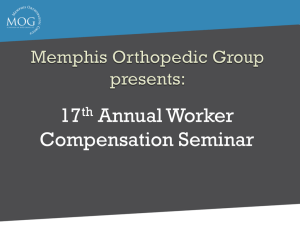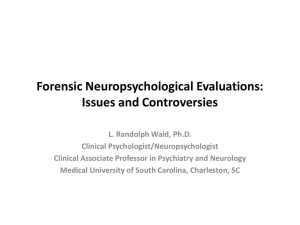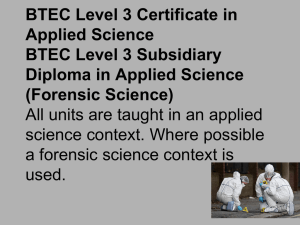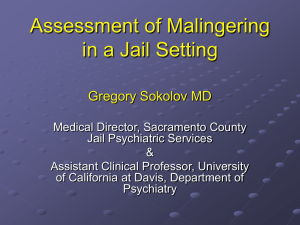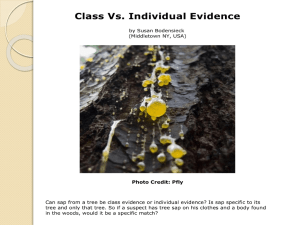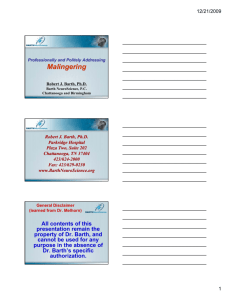The Assessment of malingering with the M-FAST
advertisement
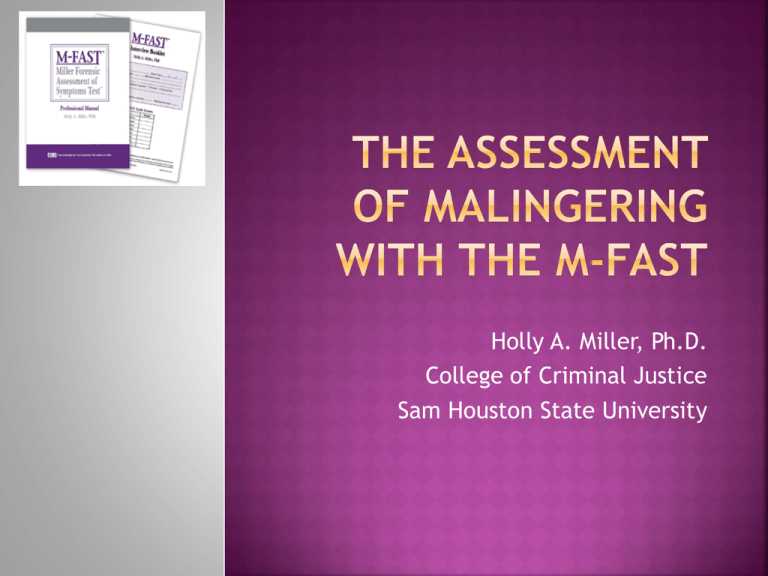
Holly A. Miller, Ph.D. College of Criminal Justice Sam Houston State University Malingering Theory and assessment Miller Development of the M-FAST Utility of the M-FAST Forensic Assessment of Symptoms Test Brief overview of studies Administration and scoring of the M-FAST Practice administration Interpretation Questions The DSM-IV-TR defines malingering as: Intentional production of false or grossly exaggerated physical or psychological symptoms, motivated by external incentives (APA, 2000) Why might someone malinger? Prevalence of malingering Around 8% of general evaluations Around 20% of forensic evaluations Miller, 2000; Rogers & Cruise, 2000; Rogers, Salekin, Sewell, & Goldstein, 1996 When to assess for malingering Rogers suggests under these circumstances Atypical presentation of symptoms Unusually high number of unusual or obvious symptoms Nonselective endorsement of symptoms Discrepancies between reported and documented history of mental illness Why DSM criteria not just use clinical judgment? Marked discrepancy between reported impairment and objective findings Lack of cooperation during evaluation or treatment Medico-legal context presentation Presence of APD What research reports on accuracy of clinical judgment Utilizing DSM criteria results in high false-positive rates Studies strongly support that objective assessment instruments are significantly more accurate than clinical judgment (Miller, 2005; Rogers 1984; Ziskin, 1984) Miller, H. A. (2005). The Miller-Forensic Assessment of Symptoms Test (M-FAST): Test generalizability and utility across race, literacy, and clinical opinion. Criminal Justice & Behavior, 32 (6), 591-611. Study 1 – initial M-FAST items (79 items) 280 forensic patients; 5 psychiatrists; 8 psychologists M-FAST; SIRS; Mtest; MMPI-2 Study 2 – final M-FAST (25 items) 50 forensic patients; 5 psychiatrists; 8 psychologists M-FAST; SIRS; Mtest; MMPI-2 Study 1 Clinical opinion v. M-FAST results Psychiatrist Opinion ROC Curve 1.00 AUC = .72 (SE = .05) CI = .62 - .81 19 FP; 17 FN . 75 . 50 Se n sitivity . 25 0.00 0.00 . 25 . 50 . 75 1.00 . 75 1.00 1 - S pec ifi ci ty Psychologist Opinion D iagonal s egments ar e pr oduc ed by ti es . ROC Curve 1.00 M-FAST . 75 . 50 Se n sitivity AUC = .80 (SE = .04) CI = .72 - .88 15 FP; 11 FN . 25 0.00 0.00 (79 items) . 25 . 50 1 - Speci fic ity D iagonal s egm ent s ar e pr oduc ed by t ies . ROC Curve AUC = .89 (SE = .02) CI = .85 - .93 1.00 . 75 . 50 Se n sitivity . 25 0.00 0.00 . 25 . 50 1 - Speci fic ity D iagonal s egm ent s ar e pr oduc ed by t ies . . 75 1.00 Study 2 Clinical opinion v. M-FAST results Psychiatrists R O C - P s y c h ia tris ts AUC = .65 (SE = .09) CI = .47 - .83 7 FP; 7 FN Psychologists AUC = .73 (SE = .08) CI = .57 - .89 9 FP; 4 FN M-FAST (final version) AUC = .95 (SE = .03) CI = .88 – 1.00 6 FP; 1 FN 1 .0 0 .7 5 .5 0 .2 5 0 .0 0 0 .0 0 .2 5 .5 0 .7 5 1 .0 0 R O C - P s y c h o lo g is ts 1 .0 0 .7 5 .5 0 .2 5 0 .0 0 0 .0 0 .2 5 .5 0 .7 5 1 .0 0 R O C – M -F A S T 1 .0 0 .7 5 .5 0 .2 5 0 .0 0 0 .0 0 .2 5 .5 0 .7 5 1 .0 0 How Previous research has indicated important areas of assessment: Certain response styles Certain interview strategies Several instruments include assessment of response styles or were specifically designed to assess malingering to catch a malingerer MMPI-2 PAI SIRS However, there remains a need for a brief screen for malingered mental illness M-FAST items were developed to operationalize the response styles and interview strategies that have been validated for identifying individuals who are malingering Reported vs Observed symptoms (RO) Extreme Symptomatology (ES) Rare Combinations (RC) Unusual Hallucinations (UH) Unusual Symptom Course (USC) Negative Image (NI) Suggestibility (S) M-FAST is a structured interview of 25 items representing the “proven” detection strategies Administration is approximately 5-10 minutes Scoring is approximately 10 minutes Does not require the ability to read (examinee) Has been translated into Korean and Spanish M-FAST was developed using both knowngroup and simulation studies Materials include manual and 8-page interview booklet Validated on people 18 yrs and older Validated with different ethnic/race groups Validated across gender Validated with varied populations In prison On probation In forensic hospital In civil hospital Outpatient disability assessment Appropriate Malingered psychopathology (not neuro) Examinee must be able to understand items Adults 18 yrs or older Screening instrument and was not developed to be the sole determinate of malingered mental illness Professional populations and limitations requirements Mental health clinician with formal training in diagnostic interviewing and assessment M-FAST should be preceded by a clinical interview To gather both symptom information and observable behavior (RO assessment help) Read aloud instructions for administration to client Suggestibility item 1st response dictates how you ask last part of item Read items and possible responses of each item May repeat once – but offer no explanation With partner, practice administration Partner role play a malingerer Want to appear mentally ill, without elevating M-FAST score Then reverse roles Scoring instructions provided on last page of interview booklet Score individual items Score scales If more than 2 items missing, not considered valid administration Malingering is distinct from most forms of psychopathology; however the presence of malingering does not rule out a psychiatric disorder Significant consequences for malingering diagnosis Choosing of a cut score for M-FAST More acceptable to have false positives than false negatives Cut score of 6 utilized Three levels Total scale Scales Provides an estimate of the likelihood that the examinee is malingering Interpretive statement: The examinee’s total score on the MFAST was significantly elevated, indicating that this individual may be malingering mental illness. Provides information on how the individual is malingering Can make interpretive statements about scale elevations, but utilize total score for overall assessment Each scale has own “cut score” Suggestibility item (scale) Manual provides interpretative statement examples Items Next step Further malingering assessment is warranted if client elevated M-FAST Competency to stand trial – forensic inpatients Jackson, R., Rogers, R., Sewell, K. W. (2005). Forensic applications of the M-FAST: Screening for feigned disorders in competency to stand trial evaluations. Law and Human Behavior, 29(2), 199-210. Vitacco, M. J., Rogers, R., Gabel, J., Munizza, J. (2007). An evaluation of malingering screens with competency to stand trial patients: A known-groups comparison. Law and Human Behavior, 31(3), 249-260. Miller, H. A. (2004). Examining the use of the M-FAST with criminal defendants incompetent to stand trial. International Journal of Offender Therapy and Comparative Criminology, 48(3), 268-280. Validity Studies Vitacco, M. J., Jackson, R. L., Rogers, R., Neumann, C. S., Miller, H. A. Gabel, J. (2008). Detection strategies for malingering with the M-FAST: A confirmatory factor analysis of its underlying dimensions. Assessment, 15(1), 97-103. Miller, H. A. (2005). The Miller Forensic Assessment of Symptoms Test (M-FAST): Test generalizability and utility across race, literacy, and clinical opinion. Criminal Justice and Behavior, 32(6), 591-611. Veazey, C. H., Hays, J. R., Wagner, A. L., & Miller, H. A. (2005). Validity of the Miller Forensic Assessment of Symptoms Test in psychiatric inpatients. Psychological Reports, 96(3), 771-774. Guy, L. S., & Miller, H. A. (2004). Screening for malingered psychopathology in a correctional setting: Utility of the Miller Forensic Assessment of Symptoms Test (M-FAST). Criminal Justice and Behavior, 31(6), 695-716. Civil forensic settings Alwes, Y. R., Clark, J. A., Berry, T. R., Granacher, R. P. (2008). Screening for feigning in a civil forensic setting. Journal of Clinical and Experimental Neuropsychology, 30(2), 1-8. Diagnostic-specific malingering assessment Messer, J. M., & Fremouw, W. J. (2007). Detecting malingered posttraumatic stress disorder using Morel Emotional Numbing TestRevised and the Miller Forensic Assessment of Symptoms Test (MFAST). Journal of Forensic Psychology Practice, 7(3), 33-57. Guriel-Tennant, J., & Fremouw, W. J. (2006). Impact of trauma history and coaching on malingering of posttraumatic stress disorder using the PAI, TSI, and M-FAST. Journal of Forensic Psychiatry & Psychology, 17(4), 577-592. Guy, L. S., Kwartner, P. P., & Miller, H. A. (2006). Investigating the M-FAST: Psychometric properties and utility to detect diagnostic specific malingering. Behavioral Sciences & the Law, 24(5), 687702. Guriel, J., Yanez, T., Fremouw, W. J., Shreve-Neiger, A., Ware, L., Filcheck, H., & Farr, C. (2004). Impact on coaching on malingered posttraumatic stress symptoms on the M-FAST and TSI. Journal of Forensic Psychology Practice, 4(2), 37-56. Holly A. Miller, Ph.D. Assistant Dean of Undergraduate Programs Associate Professor College of Criminal Justice Sam Houston State University Huntsville, Texas 77341-2296 936-294-1686; hmiller@shsu.edu
